War and Peace Blu-ray Movie
HomeWar and Peace Blu-ray Movie 
Warner Bros. | 1956 | 208 min | Rated PG | Jan 20, 2015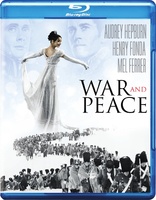
Movie rating
6.7 | / 10 |
Blu-ray rating
| Users | 5.0 | |
| Reviewer | 2.5 | |
| Overall | 2.5 |
Overview
War and Peace (1956)
Napoleon's tumultuous relations with Russia, including his disastrous 1812 invasion, serve as the backdrop for the tangled personal lives of several aristocratic families. Filmed in VistaVision.
Starring: Audrey Hepburn, Henry Fonda, Mel Ferrer, Herbert Lom, Anita EkbergDirector: King Vidor
| Romance | Uncertain |
| Drama | Uncertain |
| History | Uncertain |
| War | Uncertain |
Specifications
Video
Video codec: MPEG-4 AVC
Video resolution: 1080p
Aspect ratio: 1.78:1
Original aspect ratio: 1.85:1
Audio
English: Dolby TrueHD Mono
Spanish: Dolby Digital Mono
French: Dolby Digital Mono
Subtitles
English, French, Spanish
Discs
50GB Blu-ray Disc
Single disc (1 BD)
Playback
Region A (B, C untested)
Review
Rating summary
| Movie | 2.5 | |
| Video | 2.0 | |
| Audio | 3.5 | |
| Extras | 0.0 | |
| Overall | 2.5 |
War and Peace Blu-ray Movie Review
Ersatz Tolstoy Gets a Pseudo-Blu-ray
Reviewed by Michael Reuben January 18, 2015King Vidor's 1956 film adaptation of Leo Tolstoy's War and Peace has the distinction of being the first screen version of the Russian master's epic, but it hasn't aged well. Tolstoy's famously massive tome is one of the longest novels ever written, and it embraces so much history and philosophy that the author himself disputed that it could accurately be called a novel. Much of the book's impressive accuracy arose from its author's pure research, more journalism than art, interviewing survivors of Napoleon's invasion of Russia, reading contemporary letters and journals, doing the kind of factual sifting usually performed by historians. Large stretches of the book are devoted to Tolstoy's own theory of history. As much as it is a multi-part story, War and Peace is also a treatise on storytelling. By general consensus, the best filmed adaptation of War and Peace to date is the 1966 Russian release directed by Sergey Bondarchuk, which won the Oscar for Best Foreign Language film and, at over seven hours, is more than twice the length of Vidor's. Radical cutting of Tolstoy's story was required to achieve a screenplay (credited to six writers, including Vidor) that could be covered in just under three and a half hours. The choice decreed by producers Dino De Laurentiis and Carlo Ponti was to focus on the tormented love stories played out against the background of the French invasion. Although Vidor was able to stage several impressive battle scenes with massive casts of extras, the most extended do not occur until the latter half of the film. For much of its running time, tremulous emotion predominates over military history. Unfortunately, by today's standards, the writing, staging and acting are so stiffly unconvincing that even the presence of Audrey Hepburn cannot breathe enough life into them to make this version of War and Peace compelling. War and Peace is one of the Paramount titles being released by Warner under its licensing arrangement in the U.S. and Canada. As discussed more fully in the Video section, Warner has had less involvement with this release than with previous Paramount catalog titles it has distributed under this deal. Paramount alone is responsible for the Blu-ray's poor quality.
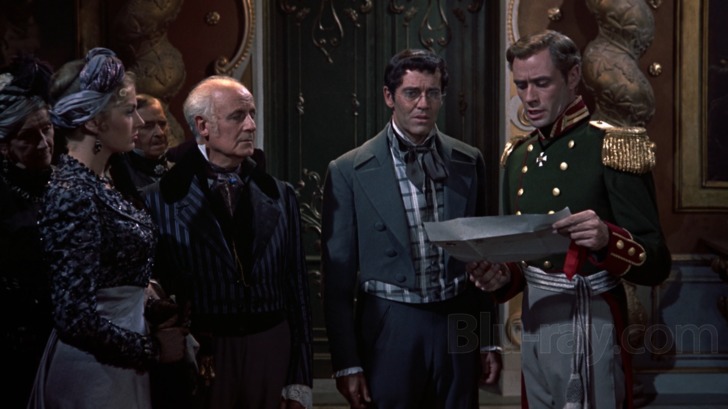
Voiceover narration describes the rise of Napoleon culminating in the French invasion of Russia in 1812, but Napoleon (Herbert Lom) does not become a major figure in the film until the third hour. A few scenes establish the strategy of Russian Field Marshal Kutuzov (Oscar Homolka), who, knowing that his army is no match for Napoleon's, resists the urging of his subordinates to engage the French commander directly. Instead, Kutuzov keeps falling back, luring the enemy ever deeper into Russia, while loyal peasants burn their crops and slaughter the livestock before the advancing enemy. Eventually Napoleon's forces will be caught very far from any hope of fresh supplies, with the snowy Russian winter bearing down on them. They will be defeated, and Russia will be saved—at a dreadful cost. But Vidor's film focuses more on the romantic tribulations of a group of Moscow aristocrats. Chief among them is Pierre Bezukhov, who, when we first meet him, is supposed to be a young man in his twenties, although he is played by fifty-year-old Henry Fonda. (Even Fonda felt that he was too old for the role, which he took—for money, he later said—after it was turned down by both Montgomery Clift and Marlon Brando.) Gangly and awkward, Pierre suffers from the stigma of illegitimacy, although his titled father acknowledges his patrimony, and Pierre will eventually inherit significant property. But Pierre never feels at ease in society, as if he always has something to prove. His sense of inadequacy is especially raw in the company of military officers like Captain Dolokhov (Helmut Dantine), because war is a business that Pierre does not understand. As the war draws near, Pierre visits the front as an observer, just to satisfy his curiosity. He also proposes an ill-considered marriage to a beautiful but shallow woman named Helene Kuragina (La Dolce Vita's Anita Ekberg, who doesn't sound like herself, because her voice was dubbed). The results are unhappy for both parties. One officer with whom Pierre does feel at ease is his close friend, Prince Andrei Bolkonsky (Mel Ferrer), son of a wealthy and powerful landowner (Wilfrid Lawson). Gentle, wise and an effective commander, Prince Andrei welcomes Napoleon's invasion as an opportunity to escape the stifling routine of social engagements to which married life in Moscow has condemned him. However, his pregnant wife, Lisa (Milly Vitale), is devastated when Andrei moves her to his family's country estate when he leaves to command his troops. With only Andrei's sister, Maria (Anna Maria Ferrero), for company, Lisa's mood rapidly deteriorates, followed by her health. The woman loved by both Pierre and Prince Andrei, though in different ways and at different times, is Natasha Rostova (Audrey Hepburn), daughter of a congenial but slightly disreputable noble family in Moscow. Charming but inexperienced and flighty, Natasha idolizes her older brother, Nikolai (Jeremy Brett, future star of Granada TV's Sherlock Holmes series). Her beauty and good nature will lead Natasha into a celebrated engagement, but it also attracts the attention of adventurers like the dastardly Anatol Kuragin (Vittorio Gassman), who romances Natasha and proposes to elope with her, even though he is (secretly) already married. The young girl has led such a sheltered life that she is helpless when gripped by what, in the modern world, would be no more than a powerful crush. As the lives of these three young people and their families interweave and criss-cross, Napoleon's army continues its advance toward Moscow, eventually occupying the Russian capital after Kutuzov orders his forces to withdraw even further. Vidor stages one especially spectacular battle sequence with hundreds of extras in French and Russian uniforms, horses charging, bayonets fixed and cannons firing continuously, but he never achieves the essential effect of Tolstoy's original work, which was to combine a sense of history's epic sweep with the immediacy of personal experience. Indeed, the realism of this one battle scene only serves to emphasize the stilted artificiality of the long dramatic sequences, as the multi-national cast struggles to convince us that they are Russians from the early 19th Century. Nothing about them feels authentic, either historically or emotionally. If you last long enough, War and Peace provides a glimpse of what it might have been when British acting legend John Mills appears late in the film as the Russian peasant, Platon Karataev, whom Pierre meets when they are both captured by the French. In his humble faith in God's plan, Karataev represents Tolstoy's idealized view of the peasantry, but Mills finds a way to imbue the character with a sense that his faith results from an inner struggle that never ends. In a vast sea of actors wearing costumes and reciting lines, Mills successfully creates the illusion that we've met a man from another place and time.
War and Peace Blu-ray Movie, Video Quality 
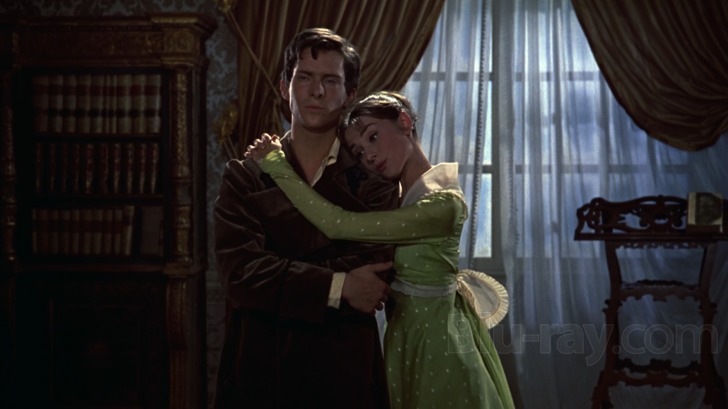
Nearly all of the prior Paramount catalog titles released by Warner under its licensing deal have been mastered by Warner with its style of menu, but War and Peace was prepared for Blu-ray entirely by Paramount. The disc has been mastered using BD-Java (a rarity on Warner discs), and it displays a Paramount logo when it loads. The bookmarking feature, pop-up menu and "progress bar" during fast forward are all implemented in the style of Paramount's Blu-rays, not Warner's. All Warner has done is add its logo to the disc art and put the disc in a case. War and Peace was a VistaVision production shot by the legendary Jack Cardiff (The Red Shoes), whose work here was nominated for an Oscar. But you'd never know it from the image on Paramount's 1080p, AVC-encoded Blu-ray. Although I am usually reluctant to opine on the age of a transfer, in this case I have no hesitation in pronouncing this an old image capture, and not a very good one. The source materials show noticeable damage of the kind that could be digitally repaired, if the studio wished to invest in doing so. Speckles, dust and small damage marks appear throughout, as does a white line from top to bottom that appears in the 57th minute and remains, with greater and lesser visibility, until approximately 1:05:35 (see screenshot 20 for a clear example). Colors are generally bland and frequently washed out, which is especially noteworthy in a film nominated by the Academy for both its cinematography and costume design. For example, in long shots involving the French and Russian armies, the difference between the blue uniforms of the former and the predominantly green or red garb of the latter should make the distinctions obvious, but the Blu-ray image is so undersaturated that the difference doesn't "pop" as it should. The splendor of Moscow's upper class social life remains understated, even at a gala ball where Natasha and Prince Andrei first dance. The burning of Moscow lacks the requisite visual impact, because pre-war Moscow is less colorful than it should be. If this were a Roger Corman low budget feature, one might be satisfied with the amount of detail in faces and clothing, but this is a major studio production with big stars shot in a high-resolution, large-negative format. The flat foregrounds, blurry backgrounds and general smoothness of the image suggests substantial filtering of the data to eliminate fine detail, and the grain pattern (when there is any) skitters unnaturally. This appears to be a master prepared for the DVD medium and repurposed for Blu-ray, perhaps with some minor tweaking. The best that can be said of it is that it doesn't suffer from the egregious oversharpening artifacts that made Paramount's Hatari! painful to watch. But that is damning with faint praise indeed. With no extras, Paramount has achieved an average bitrate of 23.995 Mbps, which is quite good for this talky 208-minute film. But War and Peace is a textbook example of how little the bitrate matters when one starts with a master that looks poor to begin with.
War and Peace Blu-ray Movie, Audio Quality 
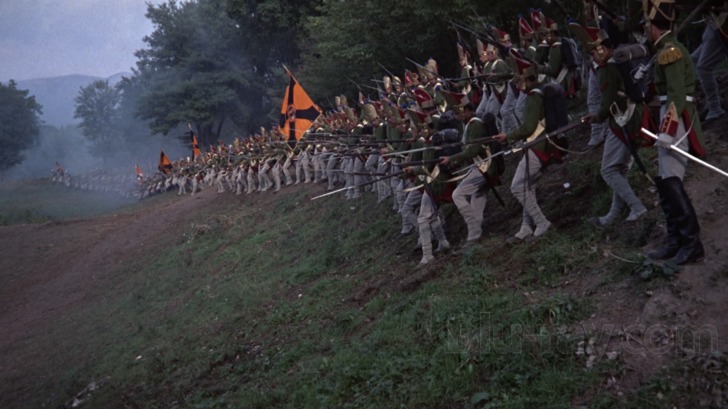
Although the disc jacket indicates that the mono soundtrack is provided in 1.0, in fact the format is 2.0 mono, with identical left and right channels, encoded in lossless Dolby TrueHD. As the film's credits indicate, a stereo version was created, but either it hasn't survived or it has not been deemed usable for some reason. The mono soundtrack is serviceable, with clear dialogue, good but limited dynamic range and decent reproduction of the score by Nino Rota (The Godfather). Those attentive to the fine points of sound editing may notice how frequently common effects (the closing of a door, the clink of a glass) are omitted from the soundtrack of War and Peace. Whether this was a deliberate choice or a cost-saving measure is impossible to say.
War and Peace Blu-ray Movie, Special Features and Extras 
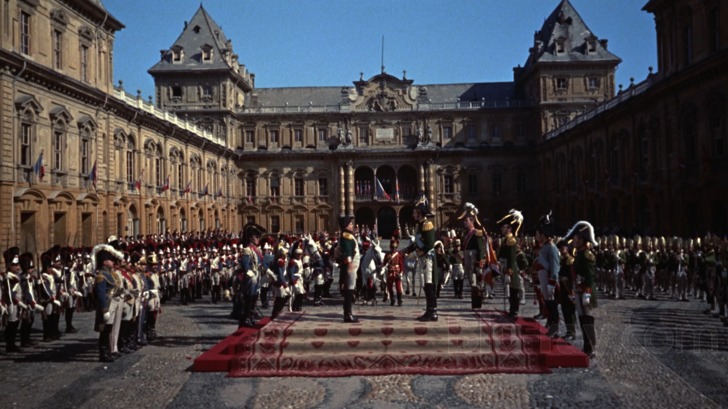
No extras are included. Paramount's 2002 DVD contained a re-release trailer and an original trailer entitled "Behind the Scenes of War and Peace".
War and Peace Blu-ray Movie, Overall Score and Recommendation 

In addition to previous adaptations, the BBC is poised to air a new six-part adaptation of War and Peace. My suggestion would be to wait for that version to come to Blu-ray, because it will almost certainly be superior to this dated effort. Even for devoted fans of Audrey Hepburn, War and Peace is not her best work, and Paramount has treated it poorly on Blu-ray.
Similar titles
Similar titles you might also like

For Whom the Bell Tolls
4K Restoration | Special Edition
1943

The Pride and the Passion
1957

Captain Corelli's Mandolin
2001

War & Peace
2016

A Farewell to Arms
1932

Wings
1927

Anna Karenina
2012

Yanks
Limited Edition to 3000
1979

That Hamilton Woman
Lady Hamilton
1941

Senso
Italian and English Versions
1954

Coming Home
Reissue
1978

Doctor Zhivago
45th Anniversary Edition
1965

Far from the Madding Crowd
2015

Cleopatra
1934

The Bitter Tea of General Yen
1933

Love and Honor
Love & Honor
2013

The Best Years of Our Lives
1946

Casablanca 4K
80th Anniversary Edition
1942

The Aftermath
2019

Fire Over England
The Vivien Leigh Anniversary Collection
1937
